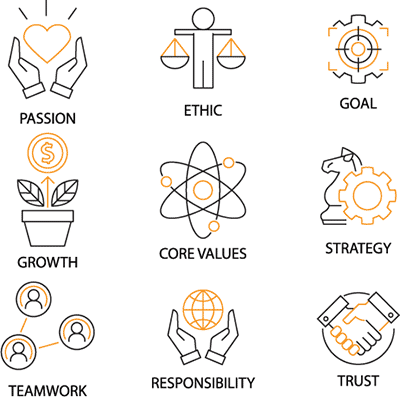
Your New Intranet Starts Here
Streamline communication, boost collaboration, and empower your team with MyHub's intuitive intranet solution.
Book a live demo now and experience the difference.
Take a Quick Tour3In the middle of a global crisis, crafting a company vision statement might seem like a low priority. With the ongoing economic uncertainty and urgent business demands, it’s easy to push long-term strategic thinking aside.
However, a compelling vision statement is a powerful leadership tool. It provides strategic direction, guides decision-making, and serves as a source of inspiration for employees. In fact, an effective vision can even help you stand out in a crowded market, enhancing your brand identity and customer appeal.
According to Gallup, only 22% of U.S. employees strongly believe that their leaders have a clear direction for the business.
If you’re looking to boost employee engagement and strengthen your brand in uncertain times, investing in a powerful vision statement could be the game changer you need.
The good news? Writing a strong company vision statement isn’t as hard as it sounds. In this guide, we’ll walk you through the essentials of creating a vision that resonates. You’ll also find real-life examples to spark your creativity.
What Is a Company Vision?
A company vision is a statement or a declaration of your organization’s long-term goals and aspirations. It answers the question: “Where do we want to go?” Unlike mission statements, which focus on present-day operations, vision statements look to the future.
Think of it as a strategic roadmap – an aspirational message that defines your desired future and aligns your team with a shared purpose. A well-written vision should be uplifting and realistic, balancing ambition with achievable outcomes.
Importantly, your vision shouldn’t be set in stone. Unexpected events – like the massive impact of COVID-19 – can shift your priorities. That’s why you should review and update your vision regularly to keep it relevant.
Ultimately, a strong vision statement supports your long-term business strategy and keeps your organization future-focused.
Company Vision Statement vs. Mission Statement: What’s the Difference?
It’s common to confuse vision and mission statements, but they serve distinct purposes. A mission statement describes what your company does, who it serves, and why it exists – essentially the present-day operations.
On the other hand, the vision statement focuses on the future. It describes where your company is headed and what it hopes to achieve in the long run.
While they differ in focus, both should be aligned and complementary. The mission sets the foundation; the vision builds the ambition on top of it.
7 Best Practices For Writing an Effective Vision Statement
Ready to write a standout company vision statement? Here are the key elements to keep in mind:
- Keep it short and memorable. The best vision statements are no longer than a sentence or two. For example, Oxfam’s is “A world without poverty,” while Google aims “To provide access to the world’s information in one click.” These examples are both concise and powerful.
- Use clear, simple language. Avoid jargon or buzzwords. Use everyday terms so anyone – employees, customers, stakeholders – can easily understand your message.
- Focus on one or two core aspirations. A clear, focused vision is more likely to drive action. Leave the finer details for your business plan or strategy document.
- Make it specific to your business. Generic statements can apply to any company. Your vision should reflect your unique identity and what sets your brand apart.
- Be future-oriented. A vision isn’t about your current state. It’s about where you want to go – and how you envision achieving growth or impact over time.
- Set an ambitious but realistic goal. A great vision inspires without sounding like a fantasy. Set high standards, but ground them in what’s achievable over time.
- Inspire and energize your team. A compelling vision gets people excited. Avoid vague goals like “being the best” – instead, create a statement that connects emotionally with your employees and customers.
How To Get Started On Your Vision Statement
Now that we’ve covered the fundamentals of what a company vision statement is and why it matters, let’s dive into the practical steps for creating one that resonates and drives your business forward.
- Review your company goals and long-term strategy. Begin by examining your organization’s core objectives. Gather input from a diverse group of employees, managers, and stakeholders to review your business’s ambitions. This is the time to think big – what are your long-term goals, and what impact do you want to make? Use tools like the SMART framework or a SWOT analysis to clarify your mission and future direction. The clearer your goals, the more focused and effective your vision statement will be.
- Identify your unique differentiators. What sets your company apart in a competitive market? It might be your commitment to sustainability, your use of innovative technology, or a proprietary process. Understanding your unique value proposition helps create a distinctive vision. Need inspiration? Analyze the vision statements of your competitors to identify gaps or opportunities that highlight your brand’s uniqueness.
- Connect with real-world impact. The most effective vision statements speak to human value and purpose. Ask yourself: How does your company improve people’s lives or contribute to a better world? Your vision should be emotionally resonant and easy to relate to, painting a vivid picture of the future you aim to build. Whether you’re helping communities, advancing technology, or protecting the environment, make sure your vision tells a compelling story.
- Test your draft company vision statement. Once you’ve developed a first draft, don’t stop there. Share it with a test group of employees or use an employee survey via your internal communications platform to collect honest feedback. You can also share it with people outside your company – partners, vendors, or even family and friends. The goal is to ensure the statement is clear, motivating, and easily understood by anyone who reads it.
- Publish and actively promote your vision. Don’t let your vision statement collect digital dust. Once finalized, integrate it into your internal communications strategy. Promote it across all channels – your intranet, newsletters, all-hands meetings, team chat apps, and even your onboarding materials. Some companies use their vision as a framework for setting individual and team goals, and as a benchmark in performance reviews.
- Revisit and revise regularly. A strong vision is not a one-time effort. While it should be forward-looking, it must also be adaptable. Circumstances change – markets shift, industries evolve. Build a review process into your planning cycle to keep your vision fresh, inspiring, and aligned with your business reality. This ensures ongoing relevance and keeps your team motivated for the long haul.
Real-World Examples Of Vision Statements
Looking for inspiration to create your own company vision statement? Here’s a collection of compelling examples from well-known global brands. These organizations have crafted powerful, memorable statements that reflect their purpose and future aspirations.
Amazon: “To be the Earth’s most customer-centric company where customers can find and discover everything they might want to buy online.”
Coca-Cola: “Our vision is to craft the brands and choice of drinks that people love, to refresh them in body and spirit. And done in ways that create a more sustainable business and better shared future that makes a difference in people’s lives, communities, and our planet.”
Starbucks: “To establish Starbucks as the premier purveyor of the finest coffee in the world while maintaining our uncompromising principles while we grow.”
Samsung: “Inspire the world, create the future.”
Ben & Jerry’s: “Making the best ice cream in the nicest possible way.”
Amnesty International: “Our vision is a world in which every person enjoys all of the human rights enshrined in the Universal Declaration of Human Rights and other international human rights standards.”
Apple: “To make the best products on Earth, and to leave the world better than we found it.”
Walmart: “To be the destination for customers to save money, no matter how they want to shop.”
These company vision statements are short, clear, and emotionally engaging. They communicate big ideas in simple language while reflecting each company’s unique brand identity.
Company Vision Statement Examples From Smaller Organizations
The big players don’t have a monopoly on great vision statements. Smaller organizations and nonprofits can also create vision statements that inspire and guide their teams. Here are a few strong examples from MyHub intranet customers:
Guthrie Bowron: “The vision for Guthrie Bowron is to be New Zealand’s most inspiring and popular home decorating destination.”
SportsArt (Washington-based): “Turn every workout into usable, clean and renewable energy.”
Scotland Excel: “To provide innovative, transformative solutions for local and national public services across Scotland.”
Marin County, Northern California: “To provide excellent services that support healthy, safe and sustainable communities; preserve Marin’s unique environmental heritage; and encourage meaningful participation in the governance of the County by all.”
These statements prove that no matter your company size, you can still define a compelling vision. What matters most is clarity, purpose, and alignment with your organizational values.
Company Vision Statements: Inspire And Motivate
It’s easy to dismiss vision statements as corporate fluff – but in reality, they’re vital tools for engaging employees, inspiring leadership, and strengthening your brand identity.
A well-crafted vision statement can:
- Inspire employees to bring their best selves to work every day
- Motivate teams by giving them a shared purpose and future goal
- Differentiate your brand in a crowded marketplace
- Guide strategic decisions and goal-setting at every level of the organization
So, if you’re preparing to launch a new business vision statement this year, keep these key tips in mind:
- Keep it short, simple, and memorable.
- Ensure it’s aspirational, but still grounded in reality.
- Involve staff and leadership in the creation process.
- Embed the vision in your strategic planning and daily operations.
- Revisit and refine your vision regularly to reflect changes.
- Use it to spark passion and belief across your workforce.
MyHub is a trusted provider of cloud-based intranet software. From enhancing internal communication to boosting collaboration and streamlining daily processes, our intranets help businesses thrive. Easy to set up and fully customizable, MyHub’s intranet solutions are used by organizations around the world.
Want to see how an intranet can support your company’s goals and bring your vision to life? Book a free demo or start your 14-day no-obligation trial today!
FAQ
What is a company vision?
A company vision statement describes your organization’s long-term goals and desired future state. It serves as a guiding light for strategy and decision-making.
How is a vision statement different from a mission statement?
A vision statement looks to the future and defines where the company wants to go. A mission statement focuses on present-day operations and why the company exists.
Why is a vision statement important for my business?
It unites your team around a shared goal, strengthens brand identity, and helps guide long-term planning and leadership.


